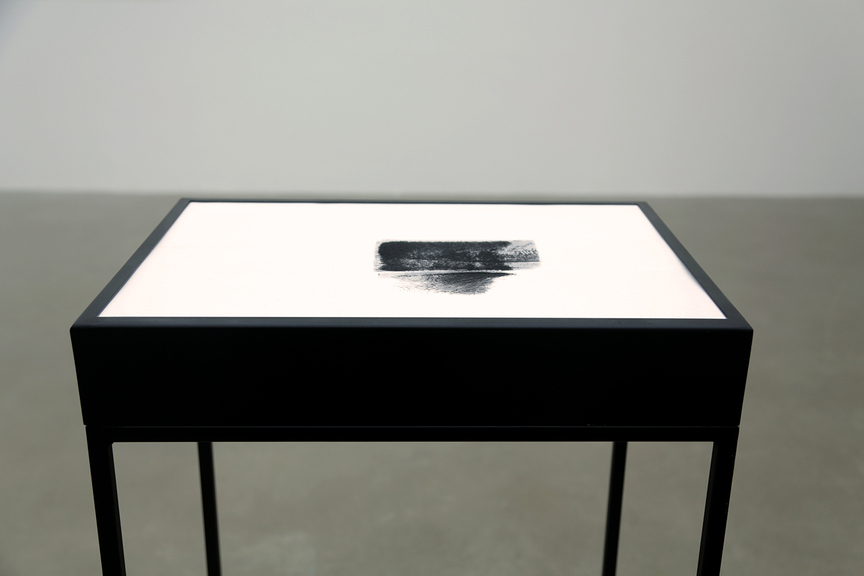-
From Current Issue
-
- Editor’s Letter Fire in the Heart
- Reviews I Gusti Ayu Kadek Murniasih
- Reviews 11th Seoul Mediacity Biennale: “One Escape at a Time”
- Dispatch Networked China
- One on One Monira Al Qadiri on Yukio Mishima
- Essays The rise of independent art spaces in pandemic-era Shanghai
- Features Tuan Andrew Nguyen
- Table of Contents
- Web Exclusives
- Archive
- Subscribe

R
E
V N
E
X
T
CARLA CHAN, Drifting Towards the Unknown, 2017, customized projection and smoke system, laser black screen and video: 18 min 30 sec. Courtesy the artist and Sexauer Gallery, Berlin.
Growing up in Hong Kong, a highly developed urban area surrounded by tropical flora and fauna, native identities are bound to develop with an unusual relationship between city and scenic outdoor life. This proved true in a recent exhibition of Carla Chan’s works at the Sexauer Gallery in the Berlin district of Weißensee. The exhibition “When the world is left only black and grey” was a fitting (if ironic) title for the gray winter months in the city. The entire show was kept in subdued tones—it featured only black-and-white works, a trademark of the Hong Kong artist Chan who travels back and forth between Berlin and her hometown.
Upon entering the somberly lit space, a mist permeated the atmosphere. While the Sexauer space—a unique location as it was formerly a semiconductor fabrication plant—cohered to the minimalist sensibility of Chan’s artistic vision, the ambience of the place increased a somewhat unruly feeling for the mythical and undetermined.
A large-scale video screen taking up a whole wall in the gallery adhered to this unsettling aura. Entitled Drifting Towards the Unknown (2017), the monotone sequences showed the perpetual movement of dark waves. Projected from above onto two layered screens and partly concealed by smoke, the work oscillated between two- and three-dimensionality and enhanced the uncertainty of one’s own (human) perception in the space. Even more so, the emanating smoke was linked to the movement of the images on screen, removing almost all traces of authorship in its automated algorithm.
In her artistic practice, Chan reflects on her personal relationship with nature. The artist who long since suffers from entomophobia (fear of insects) and a general fear of solitude in nature, was shaped by her youth in the crowded, urbanized traffic hub of Hong Kong. To compensate for this irrational anxiety, Chan processes her uneasiness toward natural forces through digital and analog works. For this exhibition, the artist reflects on both extremes of her experience with the particularities of Hong Kong life: the intrinsic beauty of untouched topographies and the process of erosion of landscapes; and the highly artificial, idealized forms made by mankind.
In Clouded White #1 to #4 (all 2017), a series of paper sketches made from carbon powder and glue, Chan offers a hybrid version of natural and idealized artistic modes. Although these works seem to follow a rather straightforward creation process—a black mountain range is depicted on white paper, sometimes with a sole person in the foreground—Chan’s images are determined by a degree of chance. A video screen installed in an adjacent room reveals the underlying qualities of their creation: after meticulously treating the surface with adhesive and spreading coal powder on the large format, the artist carries out one unanticipated, energized movement by sweeping up the piece of paper. The act creates a nebula of coal that surges forward and scatters the powder unevenly on the page, all the while polluting the artist’s immediate surroundings. The moment of dynamic, toxic performance complicates the age-old idea of coal sketches on paper, a dramatic juncture hardly visible in the finished works.
Other works in the exhibition emphasized Chan’s technical affinity towards questioning rules of nature. In Between Happening #2 and #3 (2017), the dynamics of the landscape motif are controlled by a custom-built magnetic mechanism. Iron powder on top of a horizontally placed screen prints is put in motion by a magnet underneath, slowly moving from one side to the other. The metal fragments gently sway from left to right and vice-versa, the kinetic character of the images only revealed over time, unaffected and almost autonomous from human authority.
With pairing computer algorithms, mechanics, natural processes and their intertextual possibilities, Chan plays with ideas of untouched, natural utopia and a (man-made) construct of natural environment. In her art, the lines between fiction and reality, between artificial and lived space are blurred. How will the relationship between natural and human creation develop? Chan has no clear-cut answer. But as her poetic microcosm “When the world is left only black and grey” reveals, they are unpredictably conditioned by each other.
Carla Chan: “When the world is left only black and grey” is on view at Sexauer Gallery, Berlin, until March 25, 2017.
To read more of ArtAsiaPacific’s articles, visit our Digital Library.







